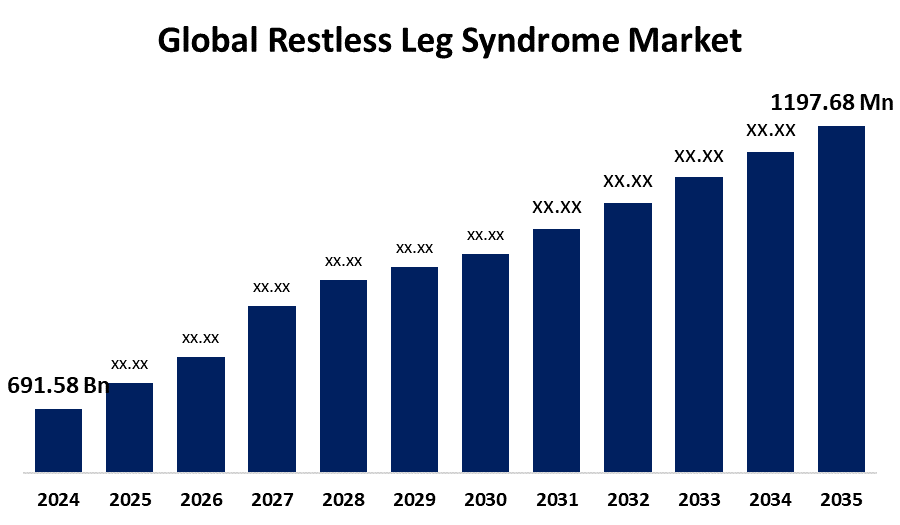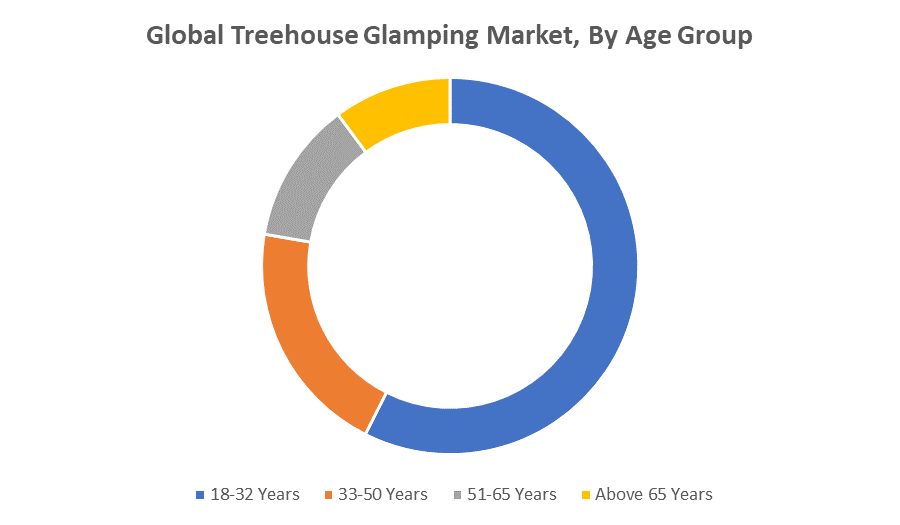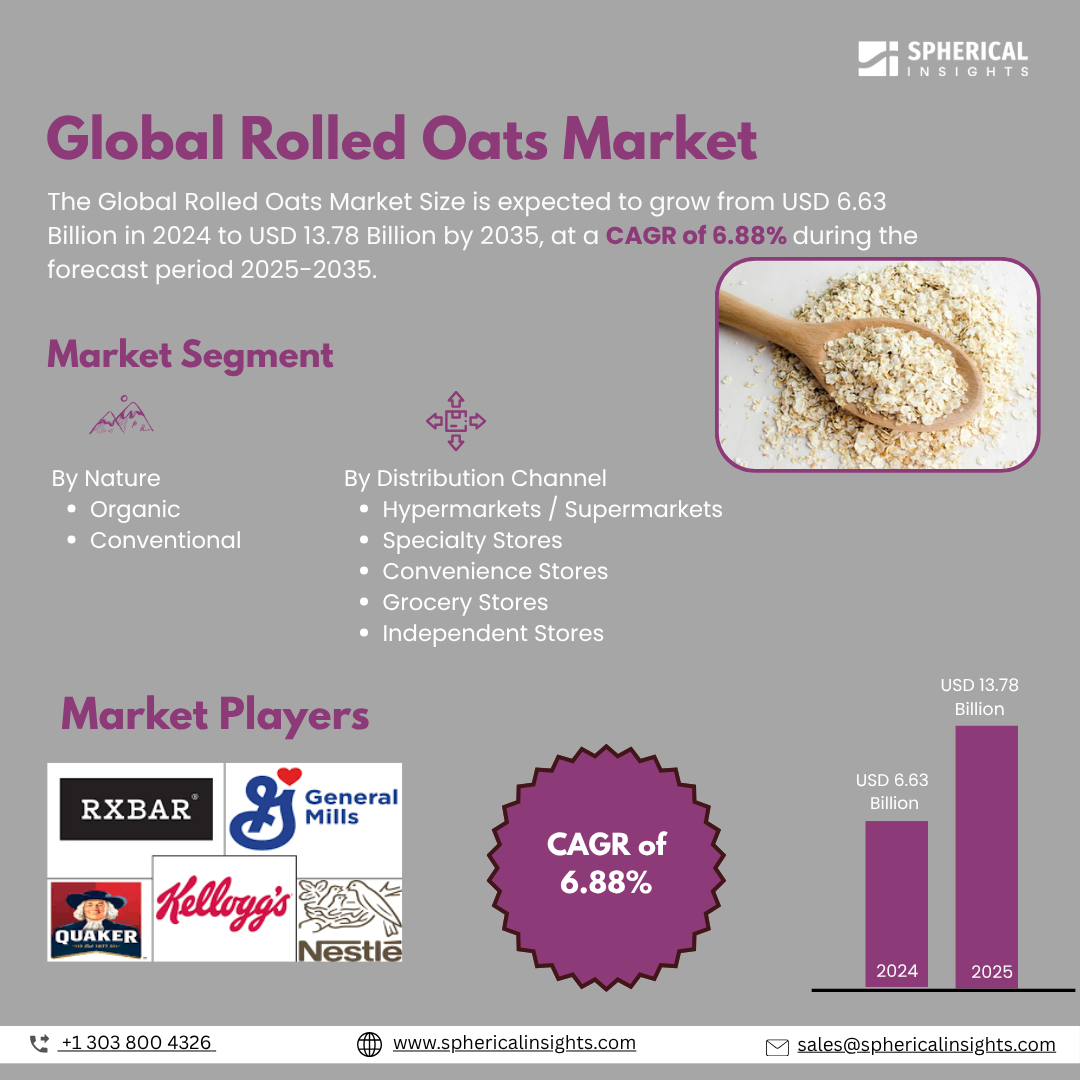Global Rolled Oats Market Insights Forecasts to 2035
- The Global Rolled Oats Market Size Was Estimated at USD 6.63 Billion in 2024
- The Market Size is Expected to Grow at a CAGR of around 6.88% from 2025 to 2035
- The Worldwide Rolled Oats Market Size is Expected to Reach USD 13.78 Billion by 2035
- Asia Pacific is expected to grow the fastest during the forecast period.

Rolled Oats Market
The Rolled Oats Market Size centers on the production and consumption of flattened oat grains, widely used in breakfast cereals, snacks, and baking. Known for their rich nutritional profile including high fiber, vitamins, and antioxidants, rolled oats are increasingly popular among health-conscious consumers. Rising demand is driven by growing awareness of healthy eating habits and the benefits of whole grains. Governments across the globe actively support the oats industry through initiatives such as agricultural subsidies, research funding, and public health campaigns promoting nutritious diets. These efforts encourage sustainable farming and boost oat production. Innovations in product offerings like organic and gluten-free rolled oats further expand the market by catering to specific dietary preferences. Overall, the rolled oats market is witnessing steady growth fueled by shifting consumer preferences toward healthier, natural food options and strong government backing that supports oat cultivation and consumption.
Attractive Opportunities in the Rolled Oats Market
- With rising consumer awareness around health and environmental sustainability, there is growing demand for organic and non-GMO rolled oats. This trend offers manufacturers the opportunity to develop and market premium, clean-label oat products that cater to health-conscious and environmentally aware customers. Expanding organic product lines can attract new customer segments willing to pay a premium for healthier and ethically produced foods.
- The increasing demand for convenient and nutritious breakfast options opens up opportunities for innovative ready-to-eat rolled oats and oat-based snacks. Products tailored for busy lifestyles, such as portable oat bars, instant rolled oats, and oat-based meal kits, can tap into the growing market of on-the-go consumers, particularly in urban areas and emerging markets.
Global Rolled Oats Market Dynamics
DRIVER: Rising demand for convenient and nutritious breakfast
Key growth factors for the rolled oats market include increasing consumer awareness of health and wellness, as oats are rich in fiber, vitamins, and antioxidants. The rising demand for convenient and nutritious breakfast options boosts market expansion. Additionally, the surge in plant-based and gluten-free diets drives the popularity of rolled oats. Government support through subsidies and health campaigns encourages oat farming and consumption. Innovations such as organic and flavored oats attract a wider customer base. Growing focus on sustainable agriculture and clean-label products further propels market growth, making rolled oats a preferred choice in health-conscious and environmentally aware communities.
RESTRAINT: Relatively longer cooking time of rolled oats compared to instant cereals
Restraining factors in the rolled oats market include the availability of cheaper alternative grains like rice and corn, which can limit oat consumption. Additionally, the relatively longer cooking time of rolled oats compared to instant cereals may deter some consumers seeking quick meal options. Fluctuations in oat crop yields due to weather conditions can impact supply and pricing. Limited awareness of oats in certain regions also restricts market growth. Furthermore, the higher cost of organic and specialty oat products may reduce affordability for some consumers. These factors collectively challenge the widespread adoption and consistent demand for rolled oats globally.
OPPORTUNITY: Expanding organic and non-GMO oat product
Rising demand for plant-based and gluten-free products opens new avenues for rolled oats as a versatile ingredient in snacks, bakery items, and dairy alternatives. Expanding organic and non-GMO oat product lines can attract health-conscious and environmentally aware consumers. Additionally, the increasing trend of on-the-go breakfast solutions creates potential for innovative ready-to-eat rolled oat products. Collaborations between manufacturers and food service providers can boost oat-based menu options in cafes and restaurants. Emerging markets with growing urban populations and rising disposable incomes also offer untapped potential. Furthermore, advances in oat processing technology allow for improved texture and taste, enhancing consumer appeal and market penetration.
CHALLENGES: Competition from alternative grains and processed breakfast options
Challenges in the rolled oats market include fluctuating raw material prices due to unpredictable weather and crop yields, affecting supply stability. Competition from alternative grains and processed breakfast options limits market share growth. Consumer preferences for quicker meal solutions can reduce demand for traditional rolled oats, which require longer cooking. Additionally, limited awareness and cultural acceptance in some regions hinder market expansion. High costs associated with organic and specialty oat products may also restrict affordability, impacting widespread adoption. These challenges require strategic innovation and marketing to overcome.
Global Rolled Oats Market Ecosystem Analysis
The global rolled oats market ecosystem includes key players like farmers, processors, manufacturers, retailers, and health-conscious consumers. Major producers such as Canada supply raw oats, which are processed by companies like Quaker Oats into various products. Distribution occurs through supermarkets and growing online channels. Market growth is driven by health trends, plant-based diets, and innovations like oat milk. Challenges include climate impact and competition from alternative grains. Advances in processing technology and sustainability initiatives also shape the market’s future opportunities and dynamics.
Based on the nature, the conventional segment held the market with the largest revenue share over the forecast period.
The conventional segment held the largest revenue share in the rolled oats market over the forecast period. This is due to its widespread availability, lower cost compared to organic options, and strong consumer preference for traditional oat products. Conventional rolled oats remain a staple in households and food manufacturing, driving consistent demand and contributing significantly to market revenue throughout the forecast period.
Based on the distribution channel, the hypermarkets/supermarkets segment held the market with the major revenue share over the forecast period

The hypermarkets and supermarkets segment held the largest revenue share in the rolled oats market over the forecast period. This is attributed to the wide variety of packaged oat products available, competitive pricing, and the convenience of one-stop shopping. These retail channels offer extensive product visibility and accessibility, driving higher consumer purchases and contributing significantly to market revenue throughout the forecast period.
Europe is anticipated to hold the largest market share of the rolled oats market during the forecast period
Europe is anticipated to hold the largest market share of the rolled oats market during the forecast period. This is driven by high consumer awareness of health benefits, strong demand for nutritious and organic foods, and well-established oat production and processing industries. Additionally, government initiatives promoting healthy diets and sustainable agriculture further support market growth in the region, making Europe a key leader in the global rolled oats market.
Asia Pacific is expected to grow at the fastest CAGR in the rolled oats market during the forecast period
Asia Pacific is expected to grow at the fastest CAGR in the rolled oats market during the forecast period. This rapid growth is fueled by increasing health awareness, rising disposable incomes, and expanding urban populations adopting Western dietary habits. Additionally, growing demand for convenient and nutritious breakfast options, along with the expansion of retail and e-commerce channels, is driving market penetration in countries like China, India, and Japan, making Asia Pacific a key emerging market for rolled oats.
Recent Development
- In February 2024, Quaker Oats launched its first-ever global brand platform, "You've Got This," marking a significant shift in its marketing strategy. This campaign celebrates everyday heroes who inspire and support others, emphasizing the brand's commitment to nourishing potential and fostering connections.
Key Market Players
KEY PLAYERS IN THE ROLLED OATS MARKET INCLUDE
- Quaker Oats Company
- General Mills
- Kellogg Company
- Nestlé
- Bagrry's India Ltd.
- Richardson International
- Bob's Red Mill
- PepsiCo
- Archer Daniels Midland Company (ADM)
- Cargill, Incorporated
- Others
Market Segment
This study forecasts revenue at global, regional, and country levels from 2020 to 2035. Spherical Insights has segmented the rolled oats market based on the below-mentioned segments:
Global Rolled Oats Market, By Nature
Global Rolled Oats Market, By Distribution Channel
- Hypermarkets / Supermarkets
- Specialty Stores
- Convenience Stores
- Grocery Stores
- Independent Stores
Global Rolled Oats Market, By Regional Analysis
- North America
- Europe
- Germany
- UK
- France
- Italy
- Spain
- Russia
- Rest of Europe
- Asia Pacific
- China
- Japan
- India
- South Korea
- Australia
- Rest of Asia Pacific
- South America
- Brazil
- Argentina
- Rest of South America
- Middle East & Africa
- UAE
- Saudi Arabia
- Qatar
- South Africa
- Rest of the Middle East & Africa
FAQs
Q: What are the key drivers of growth in the Global Rolled Oats Market?
A: Rising demand for convenient and nutritious breakfast options, increasing consumer awareness of health and wellness, government support, and growing popularity of plant-based and gluten-free diets.
Q: What are the major challenges limiting the adoption of rolled oats?
A: Competition from alternative grains and instant cereals, longer cooking times of rolled oats, fluctuating oat crop yields, and high costs of organic oat products.
Q: Which distribution channel holds the largest revenue share in the rolled oats market?
A: The hypermarkets and supermarkets segment holds the largest revenue share due to product variety, competitive pricing, and convenience.
Q: What types of rolled oats products are creating new opportunities in the market?
A: Organic and non-GMO rolled oats, ready-to-eat rolled oats, oat bars, instant oats, and oat-based snacks designed for on-the-go consumption.
Q: Who are the key players operating in the Global Rolled Oats Market?
A: Major companies include Quaker Oats Company, General Mills, Kellogg Company, Nestlé, Bagrry's India Ltd., Richardson International, Bob's Red Mill, PepsiCo, Archer Daniels Midland Company (ADM), and Cargill, Incorporated.
Q: How are government initiatives influencing the rolled oats market?
A: Governments promote oat farming and consumption through subsidies, research funding, and public health campaigns encouraging nutritious and sustainable diets.
Q: What recent marketing development has Quaker Oats introduced?
A: In February 2024, Quaker Oats launched its global brand platform "You've Got This," focusing on inspiring everyday heroes and reinforcing the brand’s commitment to nourishment.
Q: What long-term outlook is expected for the Global Rolled Oats Market (2025–2035)?
A: The market is projected to maintain steady growth driven by rising health awareness, expanding product innovation, government support, and increasing demand for sustainable and convenient foods.





